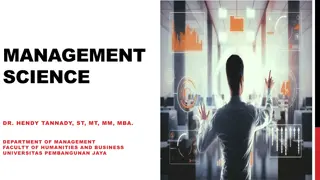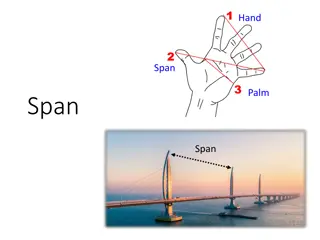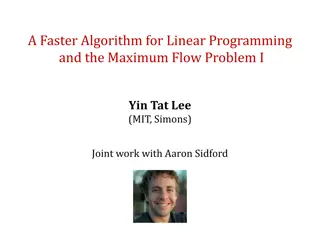Brain Cells
Delve into the fascinating world of brain cells and neurons to understand their structure, function, and communication process. Explore the microscopic level composition of the brain, the significance of neuron shapes, and the intricate workings of synapses in transmitting signals between neurons. U
1 views • 14 slides
Understanding Linear Discrimination for Classification
Linear discrimination is a method for classifying data where examples from one class are separable from others. It involves using linear models or high-order functions like quadratic to map inputs to class separable spaces. This approach can be further categorized as class-based or boundary-based, e
3 views • 37 slides
Decision Analysis and Operations Research in Management
This content delves into Management Decision Analysis and Operations Research techniques such as Linear Programming, Integer Linear Programming, Dynamic Programming, Nonlinear Programming, and Network Programming. It covers the phases of an Operations Research study, mathematical modeling for decisi
0 views • 36 slides
Understanding Linear Reservoir Baseflow Method
The linear reservoir baseflow method utilizes linear reservoirs to simulate the movement of water infiltrated into the soil. This method models water movement from the land surface to the stream network by integrating a linear relationship between storage and discharge. Users can select from one, tw
0 views • 11 slides
Understanding the Basics of the Nervous System with Dr. Mohammed Hussein
Explore the fundamentals of the nervous system in Part 1 with Dr. Mohammed Hussein, covering nerve cells, cellular processes, types of neurons, nerve structure, blood vessels, grey matter, and afferent and efferent neurons. Gain insights into the key components that make up this intricate system.
0 views • 12 slides
Understanding Narrative Structures in Media: Linear vs. Non-Linear
Explore the concepts of linear and non-linear narrative structures in media storytelling, analyzing how they are used to engage audiences effectively. Dive into well-known stories like Alice in Wonderland, Hansel and Gretel, and Jack and the Beanstalk to understand the difference between narrative a
0 views • 17 slides
Understanding Linear Transformations and Matrices in Mathematics
Linear transformations play a crucial role in the study of vector spaces and matrices. They involve mapping vectors from one space to another while maintaining certain properties. This summary covers the introduction to linear transformations, the kernel and range of a transformation, matrices for l
0 views • 85 slides
Understanding Electromyography (EMG) and Motor Neurons
Electromyography (EMG) is an electrodiagnostic technique used to evaluate muscle health by measuring electrical activity. EMG measures muscle response to nerve signals, displayed as waves on an oscilloscope. Motor neurons transmit signals from the brain to muscles, enabling movement. Upper motor neu
2 views • 8 slides
Understanding Linear Programming: An Introduction to Optimization
Linear programming, introduced by mathematician George B. Dantzig in 1947, is a mathematical technique for optimizing resource allocation in a systematic manner. It involves formulating linear relationships among variables to achieve desired results like cost minimization or profit maximization. Lin
1 views • 60 slides
Overview of Linear Regression in Machine Learning
Linear regression is a fundamental concept in machine learning where a line or plane is fitted to a set of points to model the input-output relationship. It discusses fitting linear models, transforming inputs for nonlinear relationships, and parameter estimation via calculus. The simplest linear re
0 views • 14 slides
Understanding Spiking Neurons and Spiking Neural Networks
Spiking neural networks (SNNs) are a new approach modeled after the brain's operations, aiming for low-power neurons, billions of connections, and high accuracy training algorithms. Spiking neurons have unique features and are more energy-efficient than traditional artificial neural networks. Explor
5 views • 23 slides
Comprehensive Overview of Numerical Linear Algebra Methods for Solving Linear Systems
Explore numerical linear algebra techniques for solving linear systems of equations, including direct and iterative methods. Delve into topics like Gaussian elimination, LU factorization, band solvers, sparse solvers, iterative techniques, and more. Gain insights into basic iterative methods, error
6 views • 12 slides
Understanding Cholinergic Neurons and Agonists in Pharmacology
Cholinergic neurons play a vital role in neurotransmission by utilizing acetylcholine (ACh) as a neurotransmitter. This neurotransmission involves steps like synthesis, storage in vesicles, release, receptor binding, degradation, and recycling of choline and acetate. Choline acetyltransferase cataly
0 views • 30 slides
Formulation of Linear Programming Problems in Decision Making
Linear Programming is a mathematical technique used to optimize resource allocation and achieve specific objectives in decision-making. The nature of Linear Programming problems includes product-mix and blending problems, with components like decision variables and constraints. Various terminologies
1 views • 14 slides
Linear Programming: A Tool for Optimizing Business Operations
Explore the application of linear programming in business, as exemplified by the case study of San Miguel Corporation. Learn how linear programming models can help maximize profits, optimize resource allocation, and streamline decision-making processes in various industries. Discover the fundamental
1 views • 19 slides
Understanding Basis and Dimension in Linear Algebra
Basis and dimension are fundamental concepts in linear algebra. A basis is a set of vectors that can represent any vector in a given space through linear combinations. The dimension of a vector space is determined by the number of elements in its basis. Linear independence, spanning, finite-dimensio
5 views • 13 slides
Understanding Transistor Bias Circuits for Linear Amplification
Transistor bias circuits play a crucial role in setting the DC operating point for proper linear amplification. A well-biased transistor ensures the signal variations at the input are accurately reproduced at the output without distortion. Various biasing methods such as Voltage-Divider Bias, Emitte
0 views • 7 slides
Linear Algebra Summary and Solutions
This content delves into the concept of spans in linear algebra, discussing vector sets, generating sets, linear combinations, and solution spaces. It explores the span of vectors, linear independence, and the existence of solutions in a system of equations. The visual aids provided help in understa
0 views • 9 slides
Overview of Sparse Linear Solvers and Gaussian Elimination
Exploring Sparse Linear Solvers and Gaussian Elimination methods in solving systems of linear equations, emphasizing strategies, numerical stability considerations, and the unique approach of Sparse Gaussian Elimination. Topics include iterative and direct methods, factorization, matrix-vector multi
0 views • 35 slides
Understanding the Nervous System and Sensory Neurons
The nervous system plays a crucial role in connecting the central nervous system (CNS) to limbs and organs through the peripheral nervous system (PNS). It consists of sensory neurons that transmit impulses from sensory receptors to the CNS, allowing us to perceive and respond to various stimuli. The
0 views • 23 slides
Understanding Linear Dependent and Independent Vectors
In linear algebra, when exploring systems of linear equations and vector sets, it is crucial to distinguish between linear dependent and independent vectors. Linear dependence occurs when one vector can be expressed as a combination of others, leading to various solutions or lack thereof in the give
0 views • 20 slides
Understanding Gaussian Elimination and Homogeneous Linear Systems
Gaussian Elimination is a powerful method used to solve systems of linear equations. It involves transforming augmented matrices through row operations to simplify and find solutions. Homogeneous linear systems have consistent solutions, including the trivial solution. This method is essential in li
0 views • 16 slides
Examples of Data Analysis Techniques and Linear Regression Models
In these examples, we explore data analysis techniques and linear regression models using scatter plots, linear functions, and residual calculations. We analyze the trends in recorded music sales, antibiotic levels in the body, and predicted values in a linear regression model. The concepts of slope
0 views • 11 slides
A Faster Algorithm for Linear Programming and the Maximum Flow Problem
A comprehensive overview of a new algorithm for linear programming and the maximum flow problem developed by Yin Tat Lee and Aaron Sidford from MIT and Simons. The algorithm aims to improve efficiency by reducing the number of iterations required to reach the optimal solution. It discusses the histo
0 views • 40 slides
Understanding the Nervous System: A Comprehensive Overview
The nervous system consists of the central nervous system (CNS) and peripheral nervous system (PNS), with neurons as its basic unit. Neurons function as sensory, associative, and motor types, carrying impulses within the body. Parts of a neuron include the cell body, dendrites, axon, and terminal en
2 views • 86 slides
The Oldest Applications of Linear Algebra in Ancient Civilizations
Linear algebra has roots in ancient civilizations like Egypt, where mathematical problems related to land measurement, resource distribution, and taxation were solved using techniques like Gaussian elimination and Cramer's Rule. The Rhind Papyrus from 1650 B.C. contains examples of linear systems an
0 views • 30 slides
Converting Left Linear Grammar to Right Linear Grammar
Learn about linear grammars, left linear grammars, and right linear grammars. Discover why left linear grammars are considered complex and how right linear grammars offer a simpler solution. Explore the process of converting a left linear grammar to a right linear grammar using a specific algorithm.
0 views • 44 slides
Understanding Neuronal Specialization and Functions
Explore how neuronal structures are specialized for functions, compare different types of neurons, learn about the functions of neurons, and delve into the processes of receiving, processing, and sending signals within neurons. Discover the unique features of axons and synapses, and understand how t
0 views • 16 slides
Understanding the Nervous System: Structure and Function
The nervous system is a complex network divided into the central nervous system (CNS) and peripheral nervous system (PNS). Neuroglia, or supporting cells, play vital roles in maintaining the health and function of neurons. Neurons, the fundamental units of the nervous system, vary in structure and f
1 views • 29 slides
Understanding Linear Optimization in MS&E 214
Linear optimization involves maximizing or minimizing a linear function subject to constraints. This week's focus in MS&E 214 is on linear programming, basic feasible solutions, duality theory, and extreme point solutions. The concept of linear programs, such as the example of maximizing x + 3y subj
0 views • 36 slides
Deep Learning with Theano: Installation, Neurons, and Exploration
Delve into the world of deep learning with Peter Podolski's comprehensive guide on utilizing Theano for neural network development. Explore topics such as installation on various systems, working with neurons, and unlocking the potential for CPU and GPU optimization. Discover insights on hidden node
0 views • 20 slides
Overview of the Nervous System Components and Functions
The nervous system is comprised of the central nervous system (CNS) and the peripheral nervous system (PNS). The CNS acts as the command center, interpreting sensory information and coordinating responses. The PNS conveys information to and from the CNS through somatic and visceral sensory neurons,
0 views • 48 slides
Regulation of Axon Pathfinding in Zebrafish CoPA Neurons by PTK7 Protein Domains
Understanding the involvement of PTK7 protein domains in the PCP pathway regulation of axon pathfinding in CoPA neurons of Zebrafish. The experiment aims to determine which domains of PTK7 are crucial for directing axon growth in zebrafish mutants by utilizing genetic manipulation techniques.
0 views • 12 slides
Understanding Neural Networks for Machine Learning
Explore the learning process of linear neurons, why the perceptron learning procedure cannot be generalized to hidden layers, and the importance of iterative methods in solving complex problems in the context of neural networks. The content delves into the minimization of errors, the use of real-val
0 views • 34 slides
Adapting Linear Hashing for Flash Memory Constrained Embedded Devices
This research explores the adaptation of linear hashing for improved data handling on flash memory-constrained embedded devices. Motivated by the increasing data collection by IoT devices, the study focuses on implementing database structures like a linear hash table for efficient data processing. T
0 views • 67 slides
Understanding Linear Functions in Mathematics
Linear functions play a crucial role in mathematics, focusing on elements like rate of change and initial value. Through examples involving daily car rental costs and profit from selling birdhouses, this content explores the concept of linear functions and how they are applied in real-life scenarios
0 views • 13 slides
Practical Histology: Spinal Cord Tracts and Neurons Overview
This practical histology guide covers the cervical, thoracic, and lumbar spinal cord segments, along with ascending and descending tracts, and pseudo-unipolar/unipolar neurons. It emphasizes key features such as the ventral and dorsal horns, gracile and cuneate tracts, and provides essential informa
1 views • 12 slides
Exploring the Intricacies of Mitosis, Neurons, and Endocrine System
Delve into the world of biology and neuroscience with detailed images depicting mitosis, chromatids, equator, spindle fibres, diploid and haploid cells. Explore the journey from stem cells to tissues and organs, including the Central Nervous System (CNS) components like cerebellum, cerebrum, and med
0 views • 72 slides
Understanding Linear and Nonlinear Functions in Mathematics
Explore the concepts of linear and nonlinear functions in mathematics through identifying linear and nonlinear functions from graphs, understanding the characteristics of linear functions, and identifying linear functions from tables. Learn about the constant rate of change, slope, and how to determ
0 views • 49 slides
Understanding Linear Error Control Coding and Syndrome Detection in Binary Linear Codes
Delve into the world of linear error control coding, guided by Prof. Janos Levendovszky, as we explore the development of linear codes, message vectors, error groups, and the process of selecting group leaders with detailed examples. Discover how syndrome detection and decoding tables play a crucial
0 views • 27 slides







































